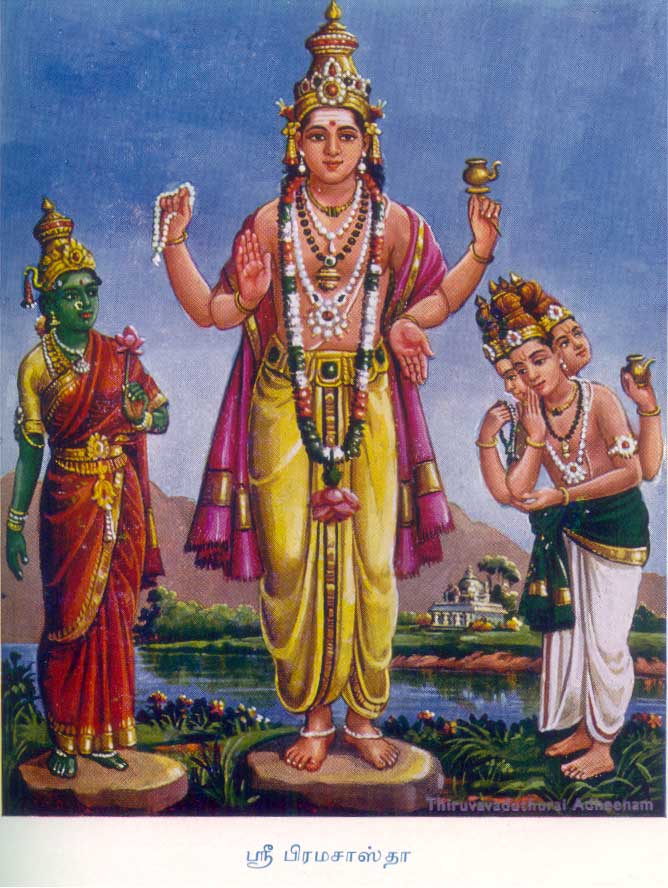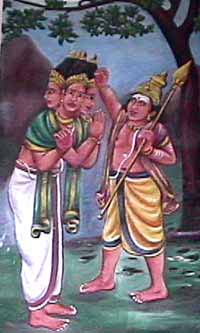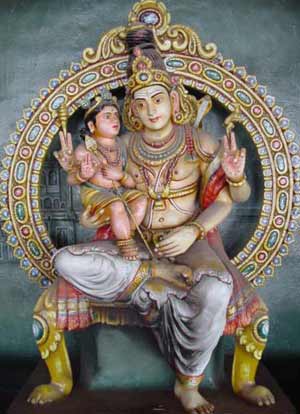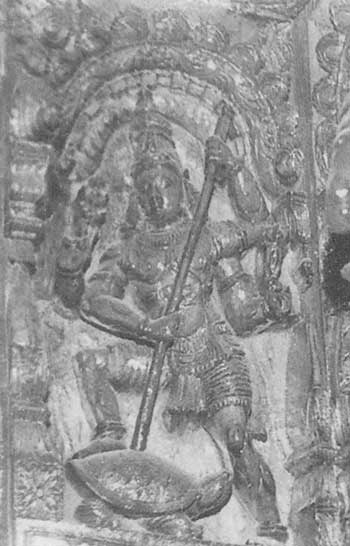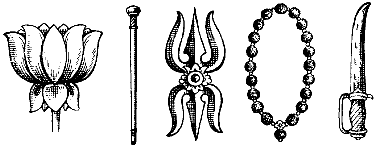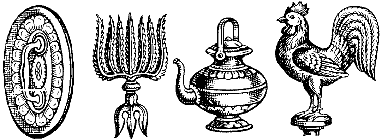
|
||||||||||||
|
| ||||||||||||
Rare Images of Brahmasāsta and Varāhasamhāra
by R.K.K. RajarajanIntroductionThe temple cars of Tamilnadu are a repository of Hindu iconography. Being massive wood carved monuments, each and every car houses not less than 200 iconographical pieces in addition to decorative motifs such as yālis and horse riders.[1] The wealth of material forthcoming from the cars are varied in dimension and need to be surveyed thoroughly. But for a major work on the subject and articles in Journals like East and West (Rome) and Journal of the Royal Asiatic Society of Great Britain and Ireland (London)[2], the subject has evaded the attention of art historians. Recently, Dr. George Mitchell and Dr. Anna Dallapicoia have undertaken a mini-project so as to enable the organisation of an exhibition of wood carvings in London. The result of the project has been published from Bombay by the journal Mārg (Vol. XLIII, No. 2, 1991). This small article takes into account two miniatures from the temple car of the
Subrahmanyasvāmi temple, Alagumalai (Coimbatore district). Both the temple
and its car are dedicated to Subrahmanya (T. Murukan, Skt. Skanda or Kumāra)
and so most of the iconographical illustrations in the car focus the forms of
the hero of the temple and mainly depict events from the Skanda Purāna (T. Kanda Purānam).[3] Besides some of the themes from Saiva and Vaisnava mythology are also illustrated in the car. Most striking among them are two pieces which give a classical shape to two of the events from Kanda Purānam and Sarabha Purānam. They are: (1) Skanda as Brahmasāsta in which the Lord punishes Brahmā for not knowing the meaning of pranava mantra and imprisons him within the bars, and (2) Skanda striking a wild boar from which Visnu emerges.
Mythological BackgroundThe two miniatures under consideration relate to two of the chief deities of the Hindu pantheon, viz., Brahmā and Visnu. But in both Skanda is the hero since he punishes the two antiheroes and establishes his superiority over them as Lord Superior of the Kaumāra cult.[4] According to the first myth, Brahmā, the Lord of Creation, and first among the Hindu Trinity, was once approached by Skanda to explain him the meaning of pranava mantra.[5] Brahmā was unable to give Skanda a proper reply. So, the latter knuckled him and threw him into the gutter. Thereupon, Skanda himself started functioning as the Lord Creator.
Later Siva, Skanda's father, rebuked him for having done so and asked Skanda whether
he knew the meaning of pranava. Skanda's
reply was ‘yes'. Then, Siva asked him to tell what it was. To take a lesson,
one should seek it with the discipline expected of a student. So, Skanda asked
Siva to be his student and know the secrets of the mantra. Then, Siva is said to have appeared before Skanda with the
head down, mouth closed with one hand and in meek submission. Skanda divulged
the secrets through a whisper. Later, at Siva's behest Brahmā was released
from the prison. The story is elaborated in Kanda
Purānam (Urpattikāndam, Ayancirainīkku
Patalam). The second myth pertains to one of the avatārs of Visnu. Visnu, the Lord of Sustenance, and second among the Trinity is said to have incarnated himself as a wild boar (Varāhamūrti) in order to relieve Mother Earth (Bhūdevi) from the clutches of a demon, called Hiranyāksa. After accomplishing the job successfully, he did not revert back to his original form as Visnu but started molesting the worlds since the wrath (ugra) did not vanish. At that time Skanda is said to have set him right by piercing his vel (Skt. Shakti-āyudha) into the Boar's body and thereby recovered the original Visnu. This episode is hinted in Sarabha Puranam (4. Arivuruttiya Carukkam, v. 47). Iconographical IllustrationsThe two miniatures found in the Alagumalai temple car are unique because no such figure carving is reported to exist. Some rare motifs of the type are said to be present in the huge cars of the Tyāgarājasvāmi temple at Tiruvārūr (Thanjāvūr district).[6] But the Alagumalai pieces are noted for novelty of the object and unique thematic elements that they include. In the first miniature Skanda is found in ālīdha posture with the left leg thrown forward and kicking a boar. The leg is placed on the back of the beast. The Lord holds the shakti in his pūrva hastas with its head striking the boar at its neck. The back left hand holds the vajrāyudha. The object in the back right hand is not clear. Skanda wears a karanda makuta, skandamālā and other ornaments. Behind the Boar, a God stands who is caturbhuja and holds the shankha and cakra in para hastas. The pūrva hastas are in anjali bandha attitude. Obviously, this is Visnu who emerges from his disguised form as the Boar (Varāha-avatāra). The illustration falls in line with the myth narrated in the foregoing account. That is to say, Visnu on warpath in his varāha form, is redeemed by Skanda, the omnipotent Lord of the Kaumāras. The other illustration shows Skanda standing in the centre with two figures of Brahmā to his front and back. Skanda knuckles Brahmā, standing in front, with his front right hand. He perhaps holds a fruit (?) in the front left hand.[7] The para hastas hold the vajra (left) and shakti (right). The Lord wears a karanda makuta, skandamālā and a pītāmbara. He is in samapāda sthānaka attitude. This stance strikingly compares with the previous iconograph because the Lord is not engaged in any arduous activity. In the previous case, he being engaged in slaughtering a wild animal, stands in ālīdha posture and wears a short loin cloth. Brahmā who receives the knuckle also stands samapāda but is shown in profile. Two of his heads are visible. He has the pūrva hastas in anjali bandha attitude. The back right hand holds the aksamālā. The back left hand is not visible. The other Brahmā who stands behind Skanda is found imprisoned within the bars. He is polycephalous with all three heads frontal. He holds the aksamālā and kamandalu in para hastas. The front hands are just suspended below (see figure at right).
The second illustration actually consists of two scenes, compressed within the same sculptural frame. One relates to punishment meted out by Skanda to Brahmā and the second pertains to the scene of imprisonment. Significance of the IllustrationsIllustrations such as discussed so far appear only in late medieval art, may be after the 14th century AD. The base for such portrayal is the Kanda Purānam in which the mythology pertaining to Skanda acquired a full-fledged form. In earlier stages, the Lord is mostly associated with Sūrapadma, Tāraka and their associates. With the growth of myths and literature, the iconographical perspective of Skanda goes on proliferating. The final stage of this evolution is reached during the late Vijayanagar period. An āgamic work called Kumāratantram was also produced which deals with the later developments in iconography. Stylistically speaking the event relating to Varāhasamhāra is of some interest. Though a work of the late medieval times, it imitates an ancient mode of illustration. To be specific, the Lord having his leg on the back of the Boar and piercing the vel into his neck is of importance. Devi-Mahisāsuramardini in early Indian art is shown in a similar pattern.[8] Evidences are the iconographs on the subject from the Udayagiri (early Gupta) and Ellora caves. The classical piece in Cave 1 at Bādāmi is also of the same type. This shows the artist's proficiency with regard to the latest developments in myth and the antique modes of iconographical representation. The theme is important for a retrospective assessment of the growth of the Kaumāra cult within the six great sects of Hinduism. Of them the most popular are Saivism, Vaisnavism and Sāktam. When compared with these three, others are not so popular. So, the Kaumāras with a view to project the personality of their cult hero, Skanda or Kumāra, invented effective myths to propagate their own sectarian creed. The result was that Siva, Visnu and Brahmā were made insignificant before their Great Lord. So, Siva appears before Skanda with folded hands and mouth shut to learn the secrets of the pranava mantra. So, Murukan in Tamil tradition is called Takappan Svāmi ‘Lord of the Father'. Brahmā is knuckled and imprisoned. Visnu is humiliated under pretext of his wrong moves after the successful completion of an avatāra's activity.[9] The appropriation of the fruit (of knowledge) from Ganapati is of some significance. According to the myth, Skanda claims superior wisdom over Brahmā and Siva. This status of eminence is pointed out by the fruit being attributed to the Lord. ConclusionThe above study shows that the temple cars are a promising area for further research. There are nearly 90 temple cars in Tamilnadu alone. Similar monuments are found in various parts of Andhra Pradesh, Karnataka and Kerala. A thorough survey and documentation of these wood carved relics of the past may bring to light the many faceted aspects of the south Indian iconography. It is indeed a challenging job. But a day should come when these paradigms, frozen into wooden caskets, are discovered and registered on the palimpsest of Indian art. References & Notes[1]Raju Kalidos, "The Wood Carvings of Tamilnadu: An Iconographical Survey", Journal of the Royal Asiatic Society of Great Britain and Ireland, London, No. 1, 1988, p. 100. [2] Raju Kalidos, Temple Cars of Medieval Tamilaham, Madurai, 1989; same author's articles in East and West (Rome): "Stone Cars and Rathamandapas", Vol. XIV, Nos. 1-3, pp. 153-73; "Visnu's Mohini Incarnation: An Iconographical and Sexological Study", Vol. XXXVI, Nos. 1-3, pp. 183-204; "Iconography and Symbolism of Pancamukha Nrsimha", Vol. XXXVII, Nos. 1-4, pp. 283-96; "Yoninilyā: Concept and Application in South Indian Art", Vol. XL, Nos. 1-4, pp. 115-53 and "Pancamukha Anjaneya in Canonic Literature and Art", Vol. XLI. Also the reference in previous note may be noted. [3] The Kanda Purānam of Kacciyappa Civāccāriyār (14th century AD) is said to be the prototype of the Sanskritic Skanda Purāna. vide Kamil V. Zvelebil, Tiru Murugan, Madras, 1981, p. 33. [4] Of the sanmatas (T. aruvakaiccamayam) Kaumāram is one; the other five being Saivam, Vaisnavam, Sāktam, Gānapatyam and Sauram. [5] Greatest among the mantras, the mysterious Om, is the pranava, the root of all cosmic wisdom. [6] Raju Kalidos, Temple Cars of Medieval Tamilaham, pp. 340-42. [7] This is very interesting because according to another myth Siva is said to have awarded a fruit (of wisdom?) to Ganapati who competed with Skanda for the prize. But in the present illustration the fruit has gone to Skanda. [8] Raju Kalidos, "Iconography of Mahisāsuramardini: A Probe into Stylistic Evolution", Acta Orientalia, Copenhagen, Vol. L, pp. 7-28, figs. 7-14. [9] A similar anecdote is related in case of Nrsimha who is ultimately overcome by Siva as Sarabhamūrti. This article first appeared in Kāla (Journal of Indian Art History Congress) Vol. I, 1994-95, pp. 129-134. Dr. R.K.K. Rajarajan
Other articles about Kaumara Iconography and Art History: |
